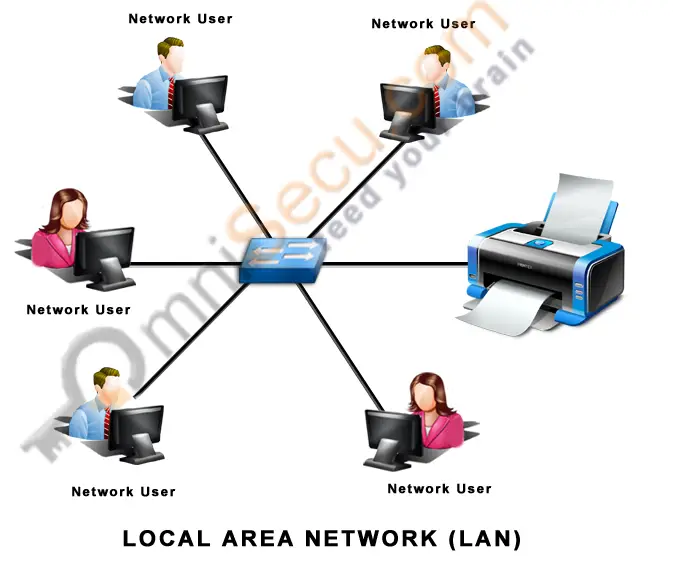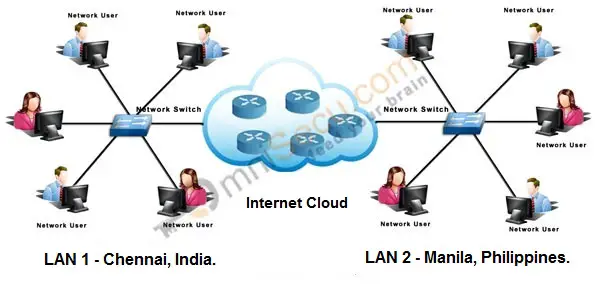Local Area Networks (LAN) and Wide Area Networks (WAN), Difference between LAN and WAN
Local Area Networks (LAN)
Local Area Network (LAN) is a computer network, which is limited to a small office, single building, multiple buildings inside a campus etc. Typically, a Local Area Network (LAN) is a private network owned and maintained by a single organization.
Below image shows a small Local Area Network (LAN) connected together using a Network Switch.

The terms Local Area Network (LAN), broadcast domain and subnet are used interchangeably throughout omnisecu.com website. Do remember that a Local Area Network (LAN) is comprised of one or more broadcast domains. A Local Area Network (LAN) may contain one or more subnets also.
Please visit below links to learn about broadcast, broadcast domain and subnets/subnetting.
- What is broadcast
- What is broadcast domain
- Benefits of Segmenting a network using a Router
- Class C Subnetting Tutorial - Part 1
- Class C Subnetting Tutorial - Part 2
- Class B Subnetting Tutorial - Part 1
- Class B Subnetting Tutorial - Part 2
- Class A Subnetting Tutorial - Part 1
- Class A Subnetting Tutorial - Part 2
Wide Area Networks (WAN)
A Wide Area Network (WAN) spans over multiple geographic locations, which is composed of multiple LANs. It is nearly impossible for a small to medium organization (except Network Service Providers) to pull network cables between their two offices in two different countries located 1000s of kilometers away. Network Service Providers (also called as ISPs) provide the connectivity solutions for Wide Area Networks (WAN).
Below image shows two Local Area Networks (LANs), located at two different geographical locations connected via Internet to create a Wide Area Network (WAN). LAN 1 is located in Chennai, India and LAN 2 is located in Manila, Philippines. The aerial distance between Chennai and Manila is about 4,400 kilometers. It is almost impossible for a small to medium business to draw cables between Chennai and Manila. We normally avail the services of an Internet Service Provider for connectivity between these two offices.

Differences between LAN and WAN
• A Local Area Network (LAN) is a private computer network that connects computers in small physical areas. Example: A small office, A Single building, Multiple buildings inside a campus etc. Wide Area Networks (WAN) is type of computer network to connect offices which are located in different geographical locations. Wide Area Network (WAN) depends mainly on Internet Service Providers (ISPs) for connection solutions.
• Local Area Network (LAN) has higher bandwidth rates. Current Local Area Networks (LANs) runs at bandwidth speeds of 100 Mbps, 1 Gbps or 10 Gbps. Wide Area Networks (WAN) has lower bandwidth rates compared with Local Area Network (LAN). Current Wide Area Networks runs on bandwidths of 20 Mbps, 50 Mbps or 100 Mbps.
• Local Area Network (LAN) bandwidth rates are almost constant. Local Area Network (LAN) bandwidth rates are dependent on characteristics of the LAN technology in use (Normally FastEthernet or Gigabit Ethernet). Since most of Wide Area Networks (WAN) connectivity solutions are dependent on Internet Service Providers (ISPs), budget related constraints affect the quality of WAN.
• Most of the current Local Area Networks (LANs) use Ethernet as the LAN Standard (FastEthernet 100 Mbps, or Gigabit Ethernet 1/10 Gbps). Normally for WAN connectivity, technologies like VPN (Virtual Private Network) over Internet, or MPLS (Multi-Protocol Label Switching) are used.
• Since Local Area Networks (LANs) are private networks, managed by dedicated local network administrators, Local Area Networks (LANs) are more reliable and secure than Wide Area Networks (WANs). Since Wide Area Networks (WANs) involve third-party service providers, WAN networks are less reliable and secure.
• Initial set-up costs for Local Area Networks (LANs) are low as the devices required to set up the networks are cheap. Initial set-up costs for Wide Area Networks (WANs) are high, because of the devices (Routers, Firewalls etc.), cables and manpower required.
• Local Area Networks (LANs) running costs are less Wide Area Networks (WANs) running costs are high. Wide Area Networks (WANs) normally have recurring monthly cost as Service Provider access fees.
• Wide Area Networks (WANs) are more congested than Local Area Networks (LANs).